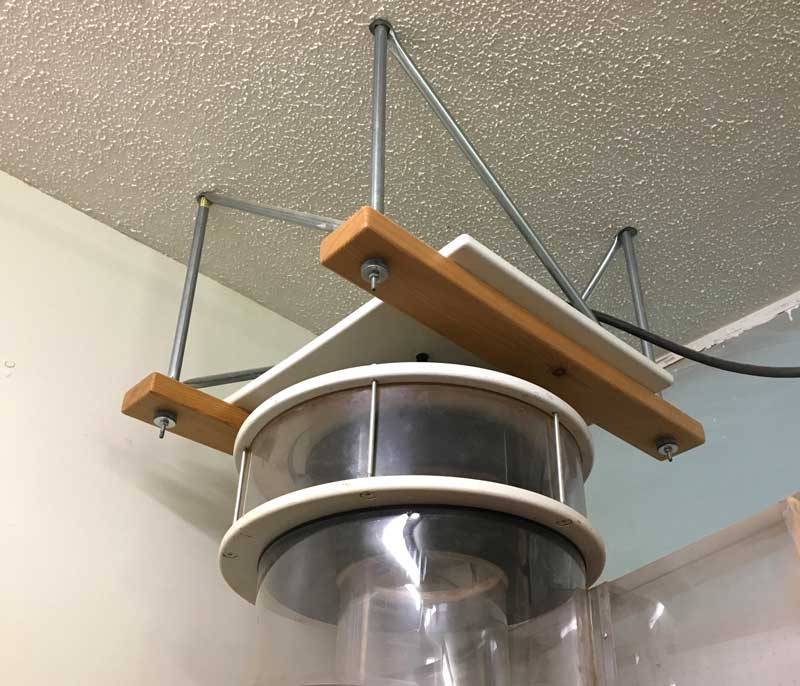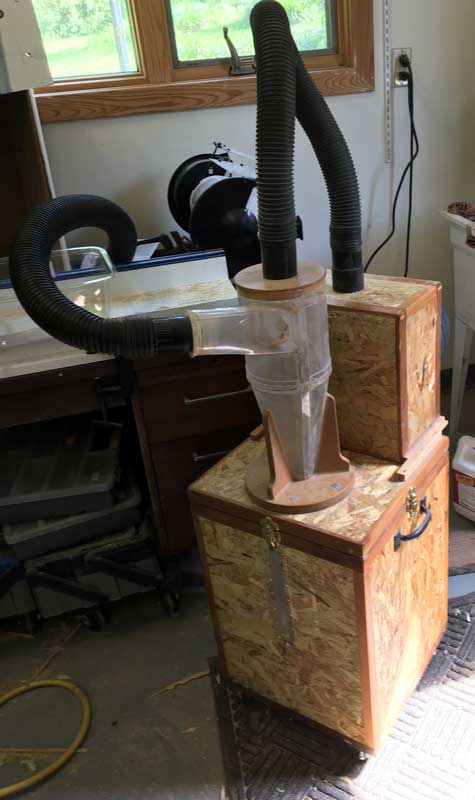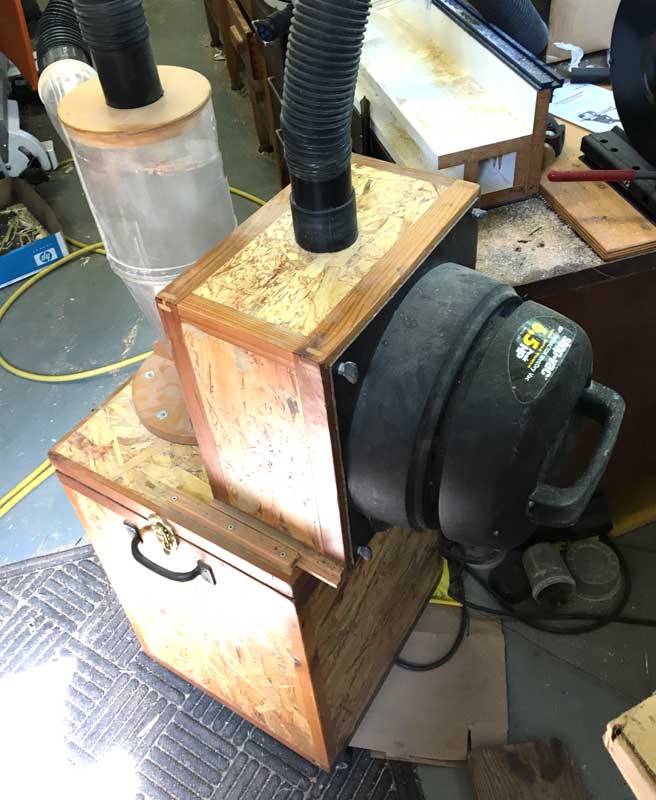Wood dust, whether on the floor or in the air, is the bane of working with
wood. Some species of wood are outright toxic, and the long-term effects on
the lungs from breathing any form of dust are bad. Bill Pentz
has an excellentre web site on dust hazards and how to defend against dust,
which I recommend highly. Years ago, I purchased and installed a cyclone-type
dust collector based on Bill Pentz's research, made by Clear Vue Cyclones. Thoe photo below
shows how I mounted it on the ceiling, using wiring conduit, all-thread, and
chemistry-lab style rubber stoppers. The allthread rods are also rubber-shielded
using medical-type rubber tubing.

Even with the double rubber isolation against conducted sound
through the building structure, the sound emitted by the surface
of the cyclone chamber and tubes, the motor, and rushing air through the
tubes make a lot of noise. However, with 6-inch ducts, it is
effective in pulling a lot of air.
The problem is how to fit out the various dust-producing tools with hoods
or other devices that can make use of this much air flow. This is not a
problem with sawing, jointing, and thickness planing, since the Minimax CU300
Classic is designed for such large ducting. However, it is a problem with
other tools, including:
- Router table. I have made extensive
modifications to the router table, and it now captures most of the
dust.
- Band saw. This came with a 4-inch dust port, connected to the
compartment surrounding the lower wheel. I was able to improve collections
slightly by fabricating a Lexan (TM) shround between the table and lower
saw compartment. However, it still throws dust from the exposed part of the
blade, onto the table.
- Chop saw. This remains a problem.
I have considered several proposed solutions
posted by others online, and have mocked up some using cardboard carton material,
but have not yet found one that really works well. I mostly rely on a
dedicated vacuum attached to the saw's (small) dust port, shown below.

 I made this vacuum from some scrap wood, a Clearvue mini-cyclone, and and an
old shop vac motor that I had replaced from the original shop vac because it
showed signs of failing. Because I was not sure how long the motor would last,
I made the motor and filter removable, figuring I could hook the cyclone and
collection box to another shop vac if this motor fails. So far it is still
working well. The box has a polycarbonate window, so you can see how full it is.
An important detail, not visible in the photos, is inside the box, under the
cyclone: a HDPE cylinder cut from a large plastic bottle. This cylinder
is necessary to ensure smooth vortex flow at the base of the cyclone.
Without this, since the box is rectangular, turbulence inside the box would
prevent material from falling out the base of the cyclone. One mistake
I made was in the orientation of the inflow "arm" of the cyclone. If it
were rotated about 45 degrees it would solve a problem I have with kinking
of the hose.
I made this vacuum from some scrap wood, a Clearvue mini-cyclone, and and an
old shop vac motor that I had replaced from the original shop vac because it
showed signs of failing. Because I was not sure how long the motor would last,
I made the motor and filter removable, figuring I could hook the cyclone and
collection box to another shop vac if this motor fails. So far it is still
working well. The box has a polycarbonate window, so you can see how full it is.
An important detail, not visible in the photos, is inside the box, under the
cyclone: a HDPE cylinder cut from a large plastic bottle. This cylinder
is necessary to ensure smooth vortex flow at the base of the cyclone.
Without this, since the box is rectangular, turbulence inside the box would
prevent material from falling out the base of the cyclone. One mistake
I made was in the orientation of the inflow "arm" of the cyclone. If it
were rotated about 45 degrees it would solve a problem I have with kinking
of the hose.
- Lathe. I have not even begun to address this. I've seen some proposed
solutions on line, but a shround close enough to cover the dust-producing
area of the lathe seems to rtestrict access to the work piece and be a
potential safety hazard.

 I made this vacuum from some scrap wood, a Clearvue mini-cyclone, and and an
old shop vac motor that I had replaced from the original shop vac because it
showed signs of failing. Because I was not sure how long the motor would last,
I made the motor and filter removable, figuring I could hook the cyclone and
collection box to another shop vac if this motor fails. So far it is still
working well. The box has a polycarbonate window, so you can see how full it is.
An important detail, not visible in the photos, is inside the box, under the
cyclone: a HDPE cylinder cut from a large plastic bottle. This cylinder
is necessary to ensure smooth vortex flow at the base of the cyclone.
Without this, since the box is rectangular, turbulence inside the box would
prevent material from falling out the base of the cyclone. One mistake
I made was in the orientation of the inflow "arm" of the cyclone. If it
were rotated about 45 degrees it would solve a problem I have with kinking
of the hose.
I made this vacuum from some scrap wood, a Clearvue mini-cyclone, and and an
old shop vac motor that I had replaced from the original shop vac because it
showed signs of failing. Because I was not sure how long the motor would last,
I made the motor and filter removable, figuring I could hook the cyclone and
collection box to another shop vac if this motor fails. So far it is still
working well. The box has a polycarbonate window, so you can see how full it is.
An important detail, not visible in the photos, is inside the box, under the
cyclone: a HDPE cylinder cut from a large plastic bottle. This cylinder
is necessary to ensure smooth vortex flow at the base of the cyclone.
Without this, since the box is rectangular, turbulence inside the box would
prevent material from falling out the base of the cyclone. One mistake
I made was in the orientation of the inflow "arm" of the cyclone. If it
were rotated about 45 degrees it would solve a problem I have with kinking
of the hose.
